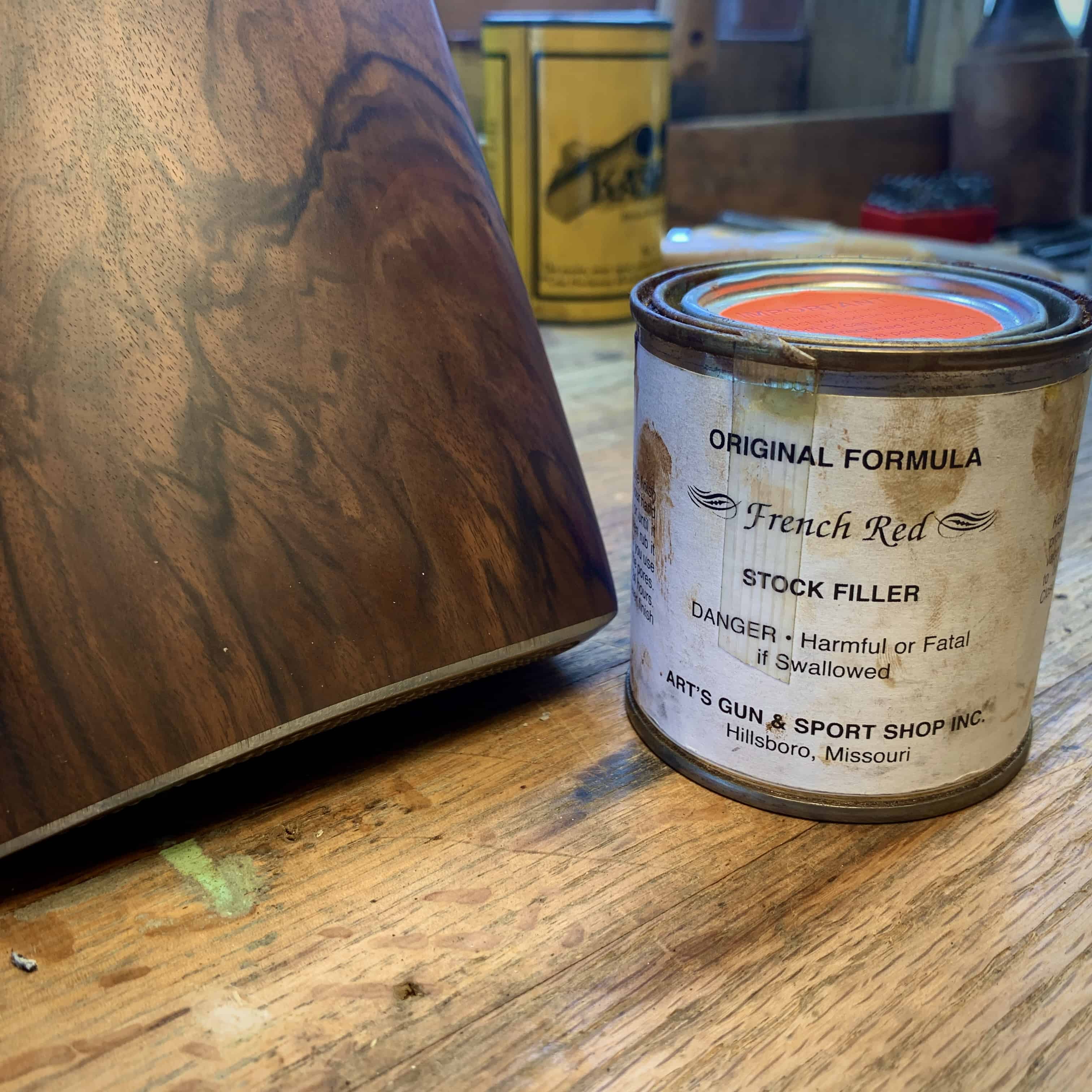
Whether refinishing a stock or applying finish to a freshly shaped stock, a stock filler is a great way to get an even finish, it is extremely simple and my preferred method of finishing a stock.
Herter’s French Red Stock Filler is best used by applying it heavily to the stock, letting it sit for 15-20 minutes, and then wiping it off with a paper towel across the grain. Once satisfied with the result, apply your favorite oil finish.
This is an excellent alternative to spending hours wet sanding your stock and trying to fill the grain. When applied correctly in conjunction with oil, it makes the figure really stand out.
Affiliate Disclosure: This article may contain affiliate links. When you use these links, I earn a small commission from each sale generated at no cost to you. This commission helps me continue to put out free content. I work a full-time job that I am very happy with; therefore, I don’t need this commission and am not obligated to speak highly of any product. Everything written is my own opinion: the good, the bad, and the ugly.

What is a Stock Filler?
Stock or wood filler is a great way to finish a gunstock as it creates a smooth and even finishes. Wood filler is thicker than the oils used for final finishing, thus filling the open grain. The Herters Stock Filler is a gritty feeling oil. The grit you feel fills the pores in your wood grain, making the surface appear smooth.
It is used in conjunction with the finish of your choice; therefore, it is not a stock finish. However, you can get a beautiful finish used with your favorite oil.

Herter’s French Red Stock Filler
Herters French Red Stock Filler is a great option for filling the pores on your gunstock. It adds a beautiful red hue that perfectly matches the Pre-64 Winchester red and the early FN Brownings that we’ve all come to love.

How to Use Stock Filler
- Sand the stock up to 400 grit, raising the grain between each grit progression.
- Open the Stock Filler and stir very thoroughly.
- Apply the filler heavily with your fingers and wait approximately 15 minutes for the filler to dry.
- Then, use paper towels to wipe the filler off across the grain. This allows the fine filler to stay in the grain. Let dry for 24 hours.
- When the filler is dry, sand the stock with 600-grit sandpaper to even out the filler. This sometimes is not needed, but I have had good results doing this. If your grain isn’t filled, repeat the process. Every piece of wood is different, and some require more than one application.
- Next, apply the oil finish you intend to use. For this example, we will use Brownells Lin-Speed Gunstock Oil. Put the oil on liberally but not so heavily that it runs. Let it dry thoroughly. In more humid areas, this may take a few days.
- Lightly rub the stock with 0000 steel wool. Don’t apply too much pressure here; your goal is to even out the finish. The weight of your hand is usually enough. Hold it up to a light and look for a consistent glare across it to get an even finish. Any dull spots need further work with the steel wool.
- The subsequent coats of oil will be very light. A few drops will cover the entire stock. Repeat this 4 or 5 times or until you are satisfied. If you apply the finish too heavily, hit it with steel wool once it’s dry to even it back out.

The Types of Walnut for Gunstocks: A Complete Look
Longevity
I refinished the Browning Sweet Sixteen to the right over five years ago and have taken it on hunts across the United States. The finish has held up well thus far; aside from the normal dents and scratches, the finish does not show any signs of wear.
One of the biggest benefits of a finish of this type is that it is easy to repair. The process explained above can be applied to small areas where necessary. You can steam out dents or sand out scratches and get it to blend very well without having to do a full refinish.
I highly recommend using this stock filler for all old Browning and Winchester stocks.

Use coupon code KTG10 to get 10% off your order of $150 or more at Brownells.
Use Stock Wax to Make Your Stock Bulletproof
While this finish is very durable, stock wax will make it even more bulletproof. I prefer Renaissance wax and have found no reason to use anything but it. It is easily applied at the beginning and end of each hunting season and adds a layer to protect against scratches. The article below details why I like it and how I use it on all of my guns.
Renaissance Wax: How to Protect Your Gunstock
Products Used:
Herters French Red Stock FIller
There is More Than One Way
While the above method is my preferred way of finishing a gunstock, there are endless other ways. Other combinations of filler and oil can be used with great success. However, as a full-time stockmaker, this is how I finish my personal gunstocks, and I really like how it performs in the field. Give it a try, and let me know how it works below!

Written by: Kurt Martonik
Kurt is a Gunsmith, Reloader, Hunter, and Outdoorsman. He grew up in Elk County, Pennsylvania, where he became obsessed with the world of firearms. Following high school, Kurt enlisted in the United States Air Force as a Boom Operator, where he eventually rose to the position of Instructor. After his military service, he attended the Colorado School of Trades(CST) in Lakewood, CO for gunsmithing. Following graduation, he accepted a job at C. Sharps Arms in Montana, where he worked as a full time stockmaker and gunsmith.